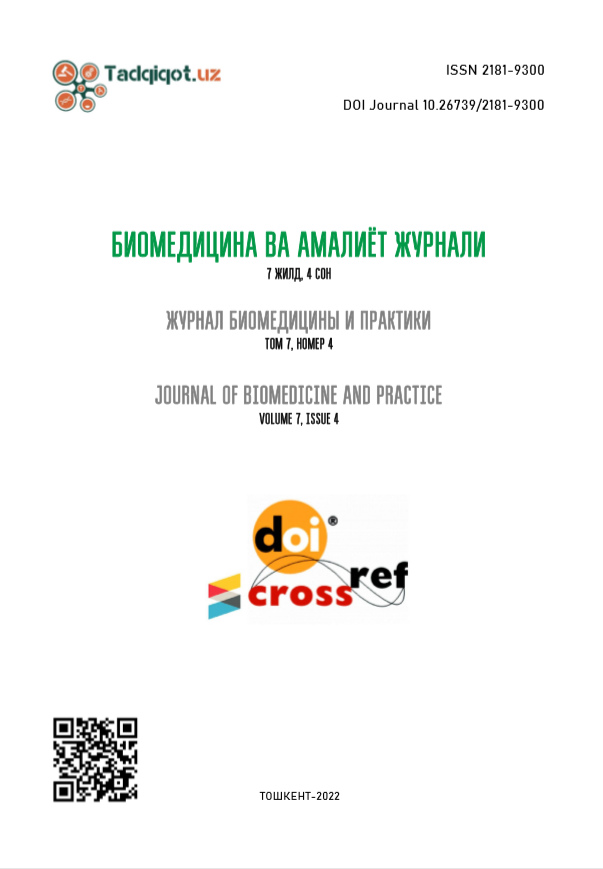PULMONARY EMBOLISM AND THE ROLE OF THE BLOOD CLOTTING SYSTEM IN ACUTE CALCULOUS CHOLECYSTITIS ON THE BACKGROUND OF OBESITY
Keywords:
Cholecystitis; Thromboembolism; OKH; HE; TEOAbstract
Objective:The authors found a significant increase in the total coagulating activity of blood, an increase in the concentration of fibrinogen and proconvertin, and an increase in the number of platelets in patients with acute calculous cholecystitis (OCC) on the background of obesity.
Methods:At the same time, the functional activity of the blood anticoagulation system is significantly reduced - the concentration of free heparin and fibrinolytic activity are reduced.
Results:When performing the HE operation, the general clotting activity of the blood according to 2 tests (recalcification time, plasma tolerance to heparin) increases. In the postoperative period, changes in the coagulogram are reduced to a further significant increase in blood fibrinogen, an increase in plasma tolerance to heparin and a decrease in anticoagulant and fibrinolytic activity of the blood.
Conclusions. A decrease in anticoagulant and fibrinolytic activity of the blood, an increase in the amount of fibrinogen, and plasma tolerance to heparin is essential in the mechanism of postoperative intravascular thrombosis.
References
Большая Медицинская Энциклопедия. -1983.
Каминский Л.С. Статистическая обработка лабораторных и клиниче¬ских данных //Медицина, 1964.
Машрапов О.А., Абдурахманов А.А. Наш опыт хирургического лечения и профилактики транзитирующей тромбоэмболии легочной артерии //XXIII Ежегодная Сессия НМИЦ ССХ им. А.Н. Бакулева. 2019. 19 - 21 мая.
Мишалов В.Г., Бондарев Р.В., Кондакова Е.Ю. и др. Особенности хирургического лечения хронического калькулезного холецистита у больных с ожирением и птозом передней брюшной стенки после ранее перенесенных операций на органах верхнего этажа брюшной полости //Хирургия Украины. 2016. №4. С.24-29.
Панченко Е.П. Диагностика и лечение тромбоэмболии легочной артерии. Клинические рекомендации Евразийской ассоциации кардиологов для практических врачей (2021) //Евразийский кардиологический журнал. 2021. (1): 44-57.
Подлипаева А.А., Муллова И.С., Павлова Т.В. и др. Новые биологические маркёры диагностики и прогнозирования риска смерти у пациентов с тромбоэмболией лёгочной артерии //Российский кардиологический журнал. 2020;25 (4S):4202.
Учеваткин А.А., Юдин А.Л., Кондаков А.К. и др. Дифференциальная диагностика острой и хронической тромбоэмболии легочной артерии по данным МСКТ //Лучевая диагностика и терапия. 2020;11(4):8-15.
Шаталова О.В., Смусева О.Н., Маслаков А.С., Горбатенко В.С. Тромбоэмболия легочной артерии: диагностика и лечение //Лекарственный вестник. 2015. Том 9. 4(60) с. 42-54.
Konstantinides S. ESC Guidelines on the diagnosis and management of acute pulmonary embolism //Eur Heart J, 2014, vol. 53, no. 45, pp. 3145-3146.
Pyko A.A., Grigorenko E.A., Statkevich T.V. et al. Vnezapnaya serdechnaya smert': epidemiologicheskie aspekty, vozmozhnosti profilakticheskich technologiy //Kardiologiya v Belarusi, 2016, № 4, S. 534-553. (in Russian).
Righini M., Robert-Ebadi H., Le Gal G. Diagnosis of pulmonary embolism //Presse Med, 2015, vol. 44, no. 12, pp. 385-391.
Schulman S., Kakkar A. K., Goldhaber S. Z., et al. Treatment of acute venous thromboembolism with dabigatran or warfarin and pooled analysis //Circulation. – 2014. – Vol. 129 (7). – Р. 764–772.

